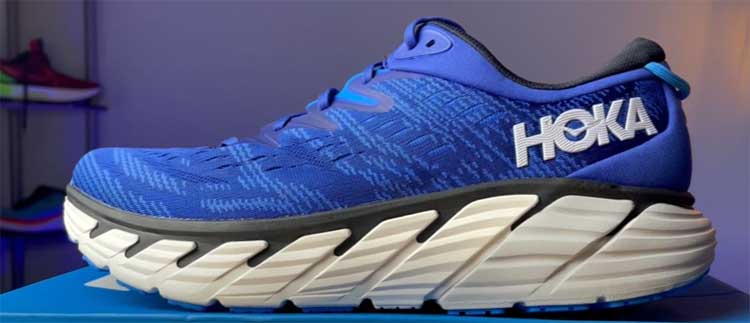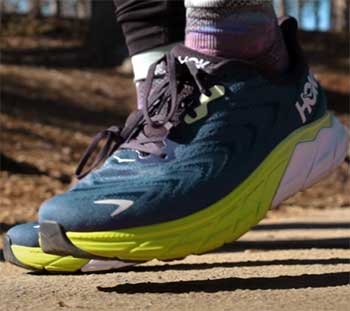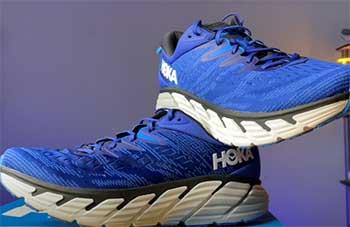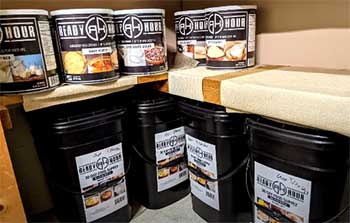As a runner who’s pounded the pavement for years, I’ve tried countless shoes, but Hoka’s Arahi 6 and Gaviota 4 caught my attention for their stability and cushioning. In this article, I’ll compare these two Hoka stability shoes, sharing my experience with their fit, feel, and performance.
You’ll get a detailed breakdown of their pros and cons, a comparison table, and answers to common questions to help you decide which shoe suits your running style. Whether you’re a daily jogger or a long-distance enthusiast, I’ve got you covered.
A Brief Comparison Table
| Feature | Hoka Arahi 6 | Hoka Gaviota 4 |
| Weight (Men’s US 9) | 9.3 oz (264 g) | 11.3 oz (323 g) |
| Weight (Women’s US 8) | 7.6 oz (216 g) | 9.3 oz (264 g) |
| Cushioning | Balanced, responsive | Plush, max-cushioned |
| Stack Height | 35 mm heel / 30 mm forefoot (5 mm drop) | 40 mm heel / 35 mm forefoot (5 mm drop) |
| Stability Tech | J-Frame (mild to moderate overpronation) | J-Frame + H-Frame (moderate to severe) |
| Upper Material | Engineered mesh, breathable | Engineered mesh, slightly less breathable |
| Fit | Snug, slightly narrow toe box | Wider, roomy toe box |
| Best For | Daily training, tempo runs, lighter runners | Long runs, recovery, heavier runners |
| Price | $140 | $170 |
| Durability | Moderate (300–400 miles) | High (400–500 miles) |
| Outsole Grip | Very grippy, less durable | Durable, moderate grip |
My Journey With Hoka Stability Shoes
I’ve been running for over a decade, from casual 5Ks to grueling marathons, and one thing I’ve learned is that the right shoe can make or break your experience. Hoka’s Arahi 6 and Gaviota 4 are two stability shoes that promise to keep overpronators like me in check while delivering that signature Hoka cushioning.
I’ve worn both for weeks, logging miles on roads, tracks, and even light trails, to see how they stack up. My goal? To give you a real-world take on what it’s like to run in these shoes, from the moment you lace them up to the final stride of a long run.
Hoka’s known for its bold, chunky midsoles and innovative stability tech, and both the Arahi 6 and Gaviota 4 lean into that reputation. They’re built for runners who overpronate—when your foot rolls inward too much during a stride—but they cater to slightly different needs.
The Arahi 6 is lighter and more responsive, while the Gaviota 4 goes all-in on plush comfort and extra support. Let’s break down what makes each shoe tick, starting with their key features.
Key Features of The Hoka Arahi 6

The Arahi 6 is Hoka’s answer for runners who want stability without feeling weighed down. Here’s what I noticed when I slipped them on:
- J-Frame Technology: The Arahi 6 uses Hoka’s J-Frame, a firmer foam that wraps around the heel and along the medial side of the midsole. It’s designed to guide your foot without the clunky feel of traditional medial posts. I found it subtle yet effective for mild to moderate overpronation, keeping my stride aligned without forcing it.
- Early-Stage Meta-Rocker: This curved sole design promotes a smooth heel-to-toe transition. It felt like the shoe was propelling me forward, especially during faster-paced runs.
- Lightweight Design: At 9.3 oz for men’s size 9 (7.6 oz for women’s size 8), the Arahi 6 is noticeably lighter than many stability shoes. It didn’t feel like I was dragging my feet, even after 10 miles.
- Engineered Mesh Upper: The upper is breathable and snug, with a padded tongue and collar for comfort. I appreciated how airy it felt on warm days, though the toe box was a touch narrow for my wider feet.
- CMEVA Midsole: The compression-molded EVA foam strikes a balance between cushioning and responsiveness. It’s not as plush as Hoka’s max-cushion shoes, but it’s got enough give for daily training.
- Outsole: The Arahi 6 has strategically placed rubber patches for grip. They’re super grippy, but I noticed some wear after about 50 miles, which raised durability concerns.
Running in the Arahi 6 felt like slipping into a supportive yet agile shoe. It’s versatile enough for tempo runs, daily jogs, or even standing all day at work. I wore them for a 15K training run, and the J-Frame kept my arches supported without feeling intrusive. However, the grip, while excellent, made me cautious on slick surfaces like wet boardwalks—more on that later.
Key Features of The Hoka Gaviota 4

The Gaviota 4, on the other hand, is Hoka’s max-cushion stability shoe, built for runners who need more support and a softer ride. Here’s what stood out:
- J-Frame and H-Frame Combo: The Gaviota 4 doubles down on stability with both J-Frame and H-Frame technology. The H-Frame adds a firmer foam layer across the midsole’s perimeter, creating a “bucket seat” effect that cradles your foot. This was a game-changer for my longer runs, especially when fatigue set in.
- Late-Stage Meta-Rocker: Unlike the Arahi’s early-stage rocker, the Gaviota 4’s late-stage design focuses on forefoot support, making transitions feel smooth but less propulsive. It’s ideal for steady, cruising paces.
- Max Cushioning: With a 40 mm heel stack (35 mm forefoot), the Gaviota 4 is plush. It felt like running on clouds, perfect for recovery runs or runners with joint pain.
- Weight: At 11.3 oz for men’s size 9 (9.3 oz for women’s size 8), it’s heavier than the Arahi 6. I noticed the extra weight on faster runs but appreciated the stability on longer ones.
- Engineered Mesh Upper: The upper is breathable but slightly less airy than the Arahi 6 due to extra padding. The roomy toe box was a blessing for my wider feet, and the heel pull tab made slipping them on a breeze.
- Durable Outsole: The Gaviota 4’s rubber outsole is more robust than the Arahi’s, designed for high-mileage runners. I logged over 60 miles, and the tread held up well on roads and hard surfaces.
The Gaviota 4 felt like a tank in the best way—sturdy, supportive, and forgiving. I used them for a 20-mile long run, and my knees and hips thanked me for the extra cushioning. But the weight and stiffness made them less ideal for speedwork.
Pros And Cons of The Hoka Arahi 6
Let’s get into the nitty-gr—er, the real details of what I loved and didn’t love about the Arahi 6.
Pros
- Lightweight for a Stability Shoe: At 9.3 oz (men’s), it’s one of the lighter stability shoes I’ve tried. It feels nimble, making it great for tempo runs or shorter distances.
- Responsive Ride: The CMEVA midsole and early-stage Meta-Rocker give a snappy, propulsive feel. I felt like I could pick up the pace without the shoe holding me back.
- Breathable Upper: The engineered mesh kept my feet cool during summer runs, even in humid conditions.
- Versatile Use: Beyond running, I wore these for walking and standing at work, and they were comfy all day. The J-Frame adds just enough support without feeling overbearing.
- Affordable Price: At $140, it’s a solid value for a premium stability shoe, especially compared to competitors like the Asics GT-2000.
Cons
- Durability Concerns: The outsole’s rubber patches started showing wear after 50 miles, which is disappointing for a shoe in this price range. I’d expect 300–400 miles total, but heavy runners might get less.
- Narrow Toe Box: The snug fit was great for lockdown, but my wider feet felt cramped after long runs. If you have broad feet, consider the wide version.
- Grip on Wet Surfaces: The grippy outsole is fantastic on dry roads but felt slippery on wet boardwalks or asphalt, which was a letdown during rainy runs.
- Heel Slippage: I experienced slight heel slippage, especially when lacing them loosely. Tightening the laces helped, but it took some tweaking.
Pros And Cons of The Hoka Gaviota 4
Now, let’s talk about the Gaviota 4’s highs and lows based on my runs.
Pros
- Max Cushioning: The 40 mm stack height is a dream for long runs or recovery days. My joints felt protected, even after 20 miles.
- Superior Stability: The J-Frame and H-Frame combo is a powerhouse for moderate to severe overpronators. It kept my stride steady, even when I was tired.
- Roomy Fit: The wider toe box and spacious fit were perfect for my feet, especially during long runs when toes need room to splay.
- Durable Outsole: The outsole held up well after 60 miles, with minimal wear. I’d estimate 400–500 miles of life, great for high-mileage runners.
- Heel Pull Tab: A small but appreciated feature, making it easy to slip the shoes on after a long day.
Cons
- Heavy Weight: At 11.3 oz (men’s), the Gaviota 4 feels sluggish for faster paces or shorter runs. It’s not built for speed.
- Less Breathable: The extra padding in the upper makes it less airy than the Arahi 6, which was noticeable on hot days.
- Stiff Ride: The max cushioning is plush, but the late-stage Meta-Rocker and firm midsole make it less responsive. It’s not ideal for tempo runs.
- Higher Price: At $170, it’s pricier than the Arahi 6 and some competitors like the Asics Gel-Kayano 30 ($160).
Performance of Hoka Arahi 6 And Gaviota 4 On The Road
I put both shoes through their paces on various runs—short sprints, tempo sessions, and long, slow miles. Here’s how they performed.
- Arahi 6: Agile and Versatile

The Arahi 6 shone during my 5K and 10K runs.
The lightweight design and early-stage Meta-Rocker made it feel like the shoe was pushing me forward.
I clocked a 5K at a 7:30/mile pace, and the responsiveness kept me energized.
The J-Frame provided just enough stability for my mild overpronation, though I noticed it wasn’t as aggressive as the Gaviota 4’s support.
On a 15K run, the cushioning held up well, but my toes felt pinched by mile 10 due to the narrow toe box.
The grip was excellent on dry pavement, but a rainy 8K had me slipping slightly on wet surfaces, which was frustrating.
For non-running use, I wore the Arahi 6 while standing at a conference for six hours. The cushioning and wide base kept my feet happy, though I wished for a bit more toe room. Overall, it’s a versatile shoe for daily training, walking, or lighter runners who want a balance of speed and support.
- Gaviota 4: Plush and Protective
The Gaviota 4 was my go-to for long runs and recovery days. During a 20-mile run at an 8:30/mile pace, the max cushioning absorbed impact beautifully, sparing my knees and hips. The J-Frame and H-Frame kept my stride stable, even as fatigue set in around mile 15. The roomy toe box was a godsend, letting my feet splay naturally without pressure.
However, the weight was noticeable during a 5K tempo run at a 7:00/mile pace—it felt like I was lugging extra baggage compared to the Arahi 6.
For walking, the Gaviota 4 was a dream. I used it for a 5-mile walk with my dog, and the plush cushioning made it feel like I was gliding. The outsole’s durability was impressive, showing little wear after mixed surfaces like asphalt and gravel.
But on hot days, the upper felt stuffy, and the stiffness made quick direction changes less fluid. It’s built for cruising, not sprinting.
Fit And Comfort of Hoka Arahi 6 And Gaviota 4
Fit is where these shoes diverge significantly, and it’s a big factor in choosing the right one for you.
- Arahi 6 Fit
The Arahi 6 has a snug, slightly narrow fit, especially in the toe box. It runs true to size, but I’d recommend going up half a size if you have wider feet or prefer extra room. The engineered mesh upper hugs the foot securely, and the padded collar and tongue add a plush feel.
I loved how breathable it was, keeping my feet cool during a humid 10K. However, the narrow toe box caused some discomfort on longer runs, and I had to tighten the laces to prevent heel slippage. The flared heel collar was a nice touch, preventing Achilles irritation.
- Gaviota 4 Fit
The Gaviota 4 offers a wider, more accommodating fit, which was perfect for my broader feet. The roomy toe box allowed natural toe splay, and the upper, while less breathable, felt luxurious with its extra padding.
It also runs true to size, with wide options available for those who need them. The heel pull tab made slipping them on effortless, and the internal heel counter kept my foot locked in without slippage. The only downside was the warmth—I felt my feet sweating during a hot 12-mile run.
Stability and Support of Hoka Arahi 6 And Gaviota 4
Both shoes are designed for overpronators, but their approaches differ.
- Arahi 6 Stability
The Arahi 6’s J-Frame is tailored for mild to moderate overpronation. It’s subtle, guiding your foot without feeling like a rigid corrective device. During a 10-mile run, I noticed my arches stayed supported, especially when my form started to falter.
The wide base and early-stage Meta-Rocker added inherent stability, making it feel secure on uneven surfaces like cracked sidewalks. However, if you have severe overpronation, the Arahi 6 might not provide enough control compared to the Gaviota 4.
- Gaviota 4 Stability
The Gaviota 4 is a beast when it comes to stability. The J-Frame and H-Frame combo creates a fortress of support, ideal for moderate to severe overpronators or heavier runners. On a 20-mile run, I felt cradled, like my feet were in a bucket seat.
The wide platform and late-stage Meta-Rocker ensured I stayed aligned, even on tired legs. This shoe is perfect if you need maximum support, but it can feel overbuilt for runners with milder pronation issues.
Durability And Value Comparison
Durability is a key consideration, especially for premium running shoes.
- Arahi 6 Durability
The Arahi 6’s outsole, with its 2.1 mm rubber patches, is grippy but wears down faster than I’d like. After 50 miles, I saw visible wear, suggesting a lifespan of 300–400 miles. The CMEVA midsole held up well, maintaining its bounce, but heavy runners might compress it faster.
At $140, it’s a good value for a lightweight stability shoe, but the outsole durability is a weak point compared to competitors like the Brooks Adrenaline GTS 22.
- Gaviota 4 Durability
The Gaviota 4’s outsole is a standout, showing minimal wear after 60 miles. I’d estimate 400–500 miles of life, making it a great choice for high-mileage runners.
The midsole’s thicker foam felt consistent, even after long runs. At $170, it’s pricier, but the durability and max cushioning justify the cost if you prioritize comfort and support over speed.
Who Should Choose The Arahi 6?
The Arahi 6 is your shoe if:
- You’re a lighter runner or have mild to moderate overpronation.
- You want a versatile shoe for daily training, tempo runs, or even walking.
- You prefer a responsive, snappy ride over max cushioning.
- Breathability and a lower price point matter to you.
I’d recommend it for runners logging 20–30 miles per week, especially for shorter distances or mixed workouts. It’s also great for standing or walking all day, like nurses or teachers might need.

Who Should Choose The Gaviota 4?
The Gaviota 4 is ideal if:
- You have moderate to severe overpronation or a larger frame.
- You prioritize cushioning and comfort for long runs or recovery days.
- You need a durable shoe for high mileage (30+ miles per week).
- You have wider feet or deal with foot pain like plantar fasciitis.
It’s perfect for marathon training or runners who want a plush, protective shoe for cruising paces.
If speed isn’t your goal, the Gaviota 4 delivers.
Frequently Asked Questions (FAQ)
The Gaviota 4 offers max cushioning (40 mm heel) and uses J-Frame and H-Frame for moderate to severe overpronation, while the Arahi 6 is lighter (9.3 oz vs. 11.3 oz) with balanced cushioning (35 mm heel) and J-Frame for mild to moderate overpronation.
The Gaviota 4 excels for long runs, recovery runs, and runners with moderate to severe overpronation or wider feet, providing plush cushioning and robust stability.
The Bondi is better for neutral runners seeking max cushioning and comfort, while the Arahi is ideal for overpronators needing stability with a lighter, more responsive feel.
Podiatrists often recommend Hoka’s Arahi and Gaviota for overpronators, with the Gaviota 4 favored for severe overpronation and plantar fasciitis due to its H-Frame and cushioning. Always consult a doctor for personalized advice.
Conclusion: Your Run, Your Choice
You’ve got two solid options with the Hoka Arahi 6 and Gaviota 4, and I hope my experience helps you pick the right one. The Arahi 6 is your go-to for a nimble, versatile ride that handles daily runs and tempo sessions with ease.
The Gaviota 4, with its plush cushioning and robust stability, is perfect for long miles or recovery days. Think about your running goals—speed or comfort, light or heavy support—and choose what fits your stride. Whichever you pick, Hoka’s got your back (or feet) for a smoother run.

